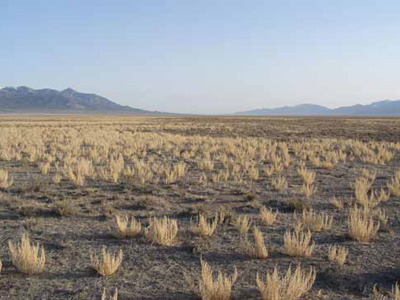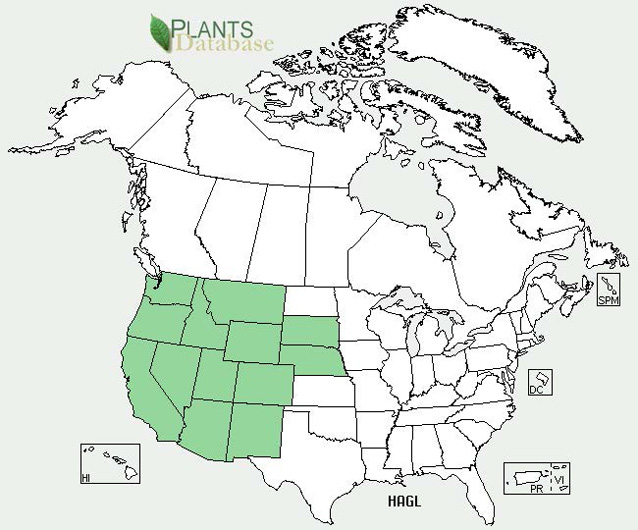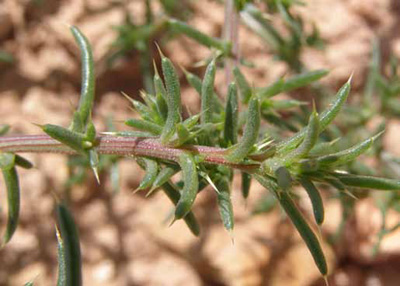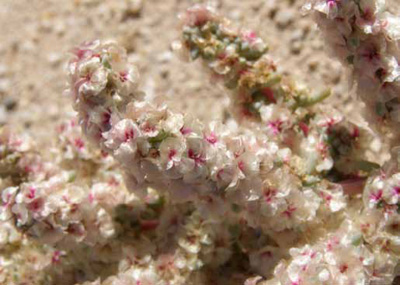Chenopodiaceae (Goosefoot family)
At a Glance

Bonnie Million / NPS
- Annual
- Many stems branch from the base of the plant.
- Leaves are small, fleshy, cylindrical, and tipped with a stiff bristle.
- Flowers cluster in the spaces between the leaf and the stem.
- Fruit is an utricle (small bladder-like protruberance).
- Seeds can be either black or brown, depending upon the time of year when the seeds mature.
Habitat and Ecology
Introduced to North America from the cold deserts of Eurasia, halogeton (Halogeton glomeratus) is currently found in arid and semi-arid regions across the western United States, especially where winters are cold. Halogeton’s invasive capabilities became apparent in the 1930s and 1940s as the widespread abandonment of farms, towns, and mining camps allowed halogeton to rapidly spread through the West. Halogeton competes poorly with established perennial vegetation, so it tends to invade open sites with bare soil, like disturbed rangelands, dry lakebeds, and roadsides. It grows on many types of soil, but it is best adapted to alkaline and saline soils.
Halogeton is able to accumulate the salt from the lower soil horizons in its tissues. When the plant dies, the salt then leaches from the tissues, increasing the salinity of the topsoil and making establishment more difficult for other plants. The foliage is also high in oxalates, which are toxic to livestock, especially sheep. Oxalates reduce calcium in the bloodstream, resulting in staggering and muscle spasms.

USDA
Description

Bonnie Million / NPS
Halogeton is an annual, succulent forb with small fleshy leaves that grows up to 1.5 feet tall. It has many main stems that branch from the base of the plant and spread low to the ground before becoming erect. During drought, the stems can turn red. The root system consists of a slowgrowing taproot and lateral spreading roots. The seedlings germinate February through August, with a peak in April. Halogeton builds its root system during the cool weather and begins rapid vegetative growth in May. It reproduces by seeds that are dispersed via wind, water, ants, animal ingestion, and road equipment. After cool-season frosts begin, the plant turns straw-colored and may remain intact through the winter.
Leaves
The leaves are small, alternate, and fleshy. They attach directly to the stem. Cylindrical in shape, each leaf is tipped with a stiff bristle. No hair occurs on the leaves, but tufts of long, white hairs occur in the spaces between the leaf and the stem.

Bonnie Million / NPS
Flowers and Fruits
The flowers are inconspicuous and do not have petals. Instead, the flowers have five petal-like sepals. The tips of the sepals are membranous and tinged greenish-yellow to red. The flowers cluster densely in the spaces between the leaf and the stem. Halogeton flowers June through September.
The fruits are utricles, or thin-walled, one-seeded fruits shaped like bladders. The fruits are enclosed by sepals, hiding the stem from view. The fruits contain flat, teardrop shaped seeds that are either black or brown, depending upon the time of year when the seeds mature. Black seeds develop before mid-August and remain viable for a year. Brown seeds, which usually develop after mid-August, are dormant at maturity and can survive for 10 years in the soil. Producing two types of seeds helps halogeton to remain established at a particular location over extended drought periods.
Etymology
Haloge’ton comes from the Greek roots hals, which means “sea, salty,” and geiton, which means “a neighbor”. Glomera’tus means clustered.
Similar Species
Before flowering, halogeton resembles immature Russian thistle (Salsola tragus) or kochia (Kochia scoparia), but Russian thistle has linear leaves without hairs in the leaf axils, and kochia has softly hairy leaves that do not have a stiff bristle at the tip.
Control Methods
Possible control methods are explained at these websites:
References
California Department of Food and Agriculture. No date. Halogeton glomeratus in Encycloweedia. Available at https://www.cdfa.ca.gov/plant/IPC/encycloweedia/weedinfo/halogeton.htm (accessed 31 March 2010).
Charters, M. L. 2009. California plant names: Latin and Greek meanings and derivations. Available at http://www.calflora.net/botanicalnames (accessed 31 March 2010).
Pavek, D. S. 1992. Halogeton glomeratus. In Fire Effects Information System. US Department of Agriculture, Forest Service, Rocky Mountain Research Station, Fire Sciences Laboratory. Available at http://www.feis-crs.org/feis/ (accessed 31 March 2010).
Prepared by Kelly Reeves, Southern Colorado Plateau Network Inventory and Monitoring Program, 2010.
Last updated: May 25, 2016






